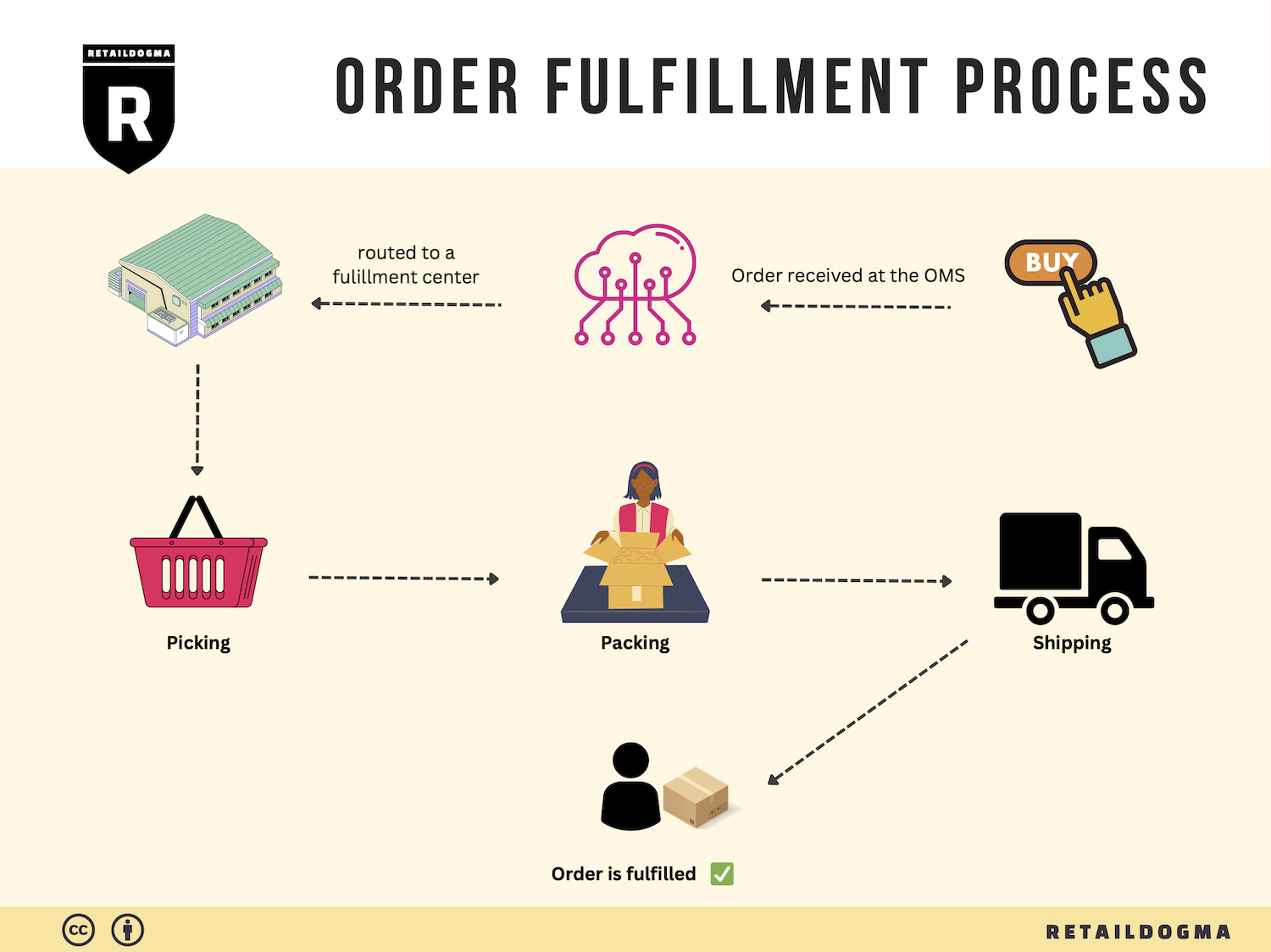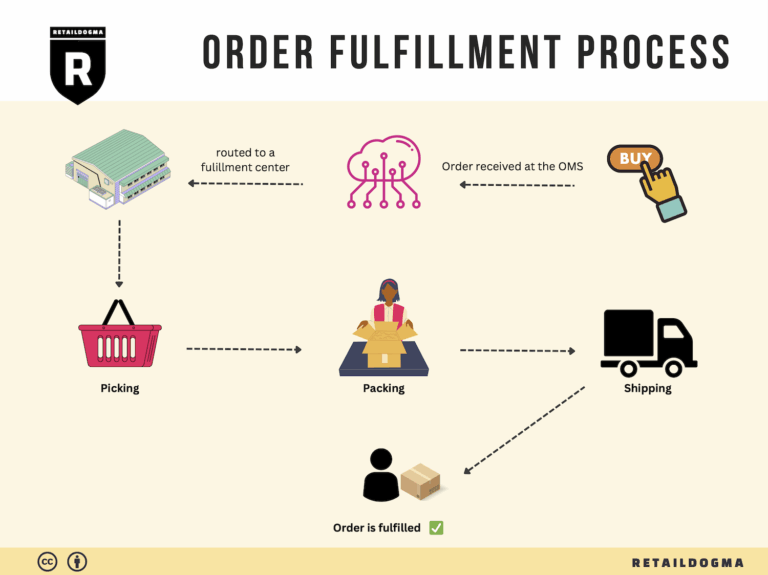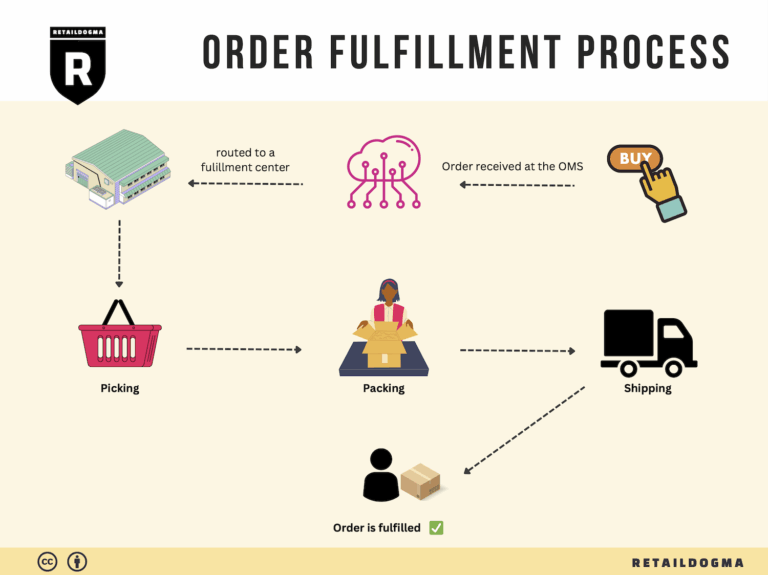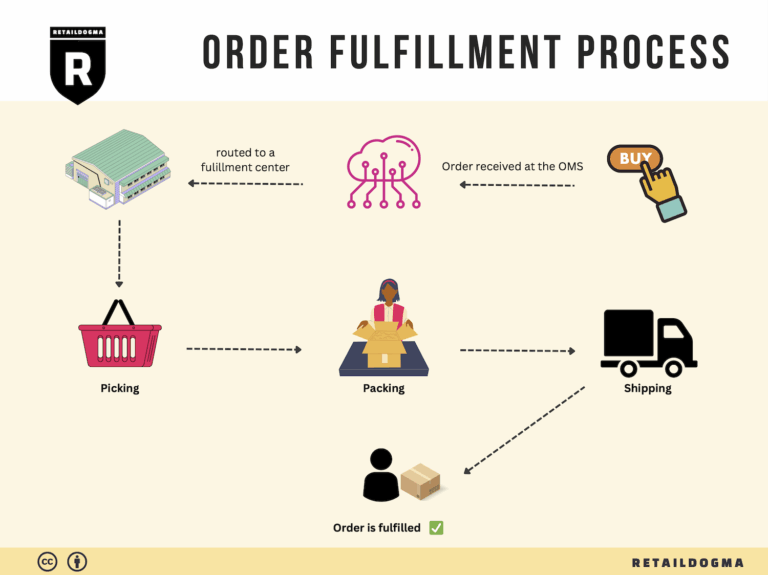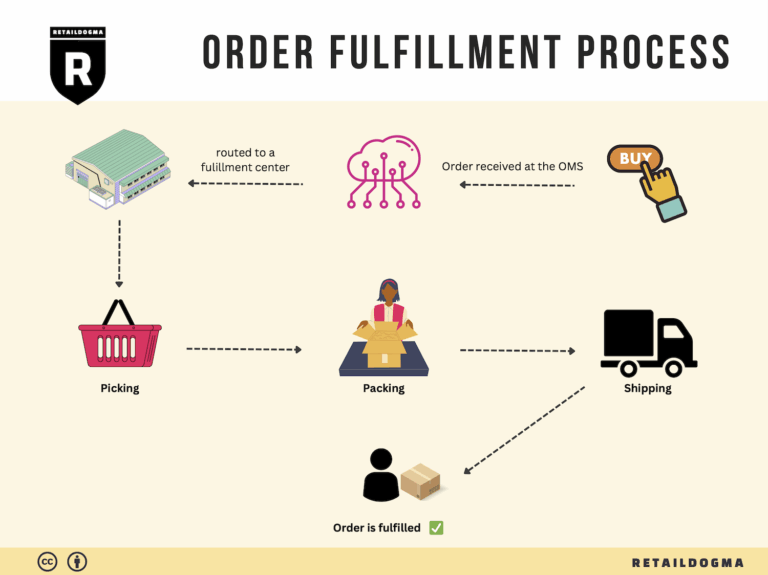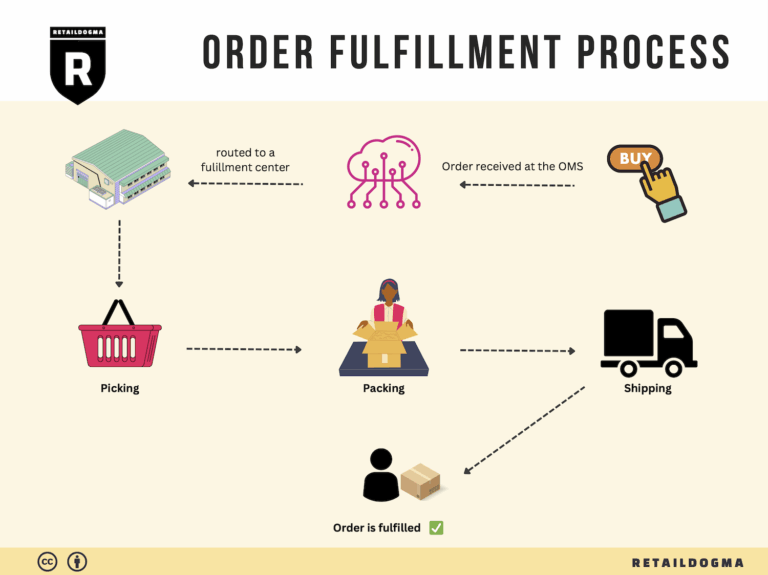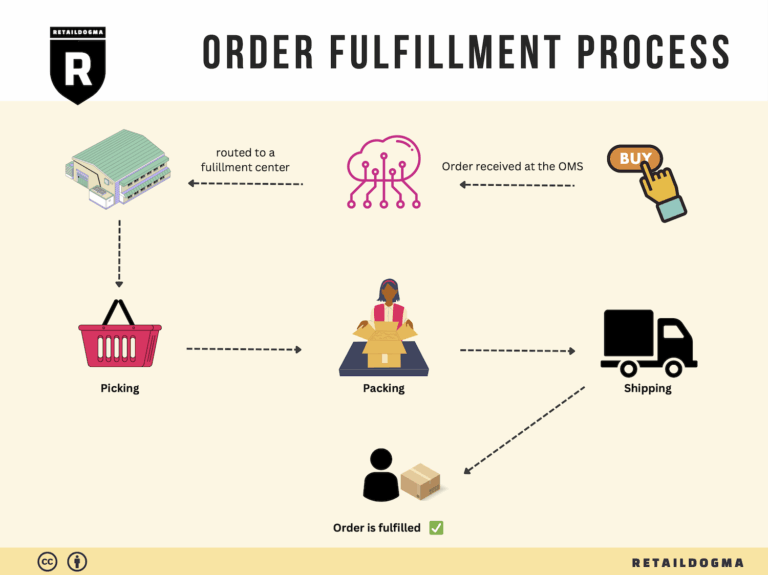Ecommerce Fulfillment Services: The Ultimate Guide (2025)
What is E-commerce Fulfillment? An Introduction for Growing Businesses
Understanding the Fulfillment Process
For many growing e-commerce businesses, the thrill of increasing sales can quickly turn into a logistical nightmare. As orders start to pour in, the tasks of packing and shipping can become overwhelming, leading to delays, errors, and dissatisfied customers. This common pain point underscores the importance of an effective fulfillment strategy—an essential component of any successful online retail operation.
At its core, e-commerce fulfillment is the process of getting a product from your inventory to your customer’s doorstep. This involves several key steps, including order processing, inventory management, packing, shipping, and handling returns. As your business scales, mastering these elements becomes crucial to maintaining a positive customer experience and operational efficiency.
This guide aims to demystify e-commerce fulfillment by exploring various models that can streamline your logistics. We will delve into options such as Third-Party Logistics (3PL) and Fulfillment by Amazon (FBA), examining their advantages and disadvantages. Understanding these models will help you choose the best fit for your business needs.
In addition to exploring fulfillment models, we will outline the core services associated with e-commerce fulfillment. These include inventory storage, order processing, packing and shipping, and returns management. By understanding these services, you can better assess what you need from a fulfillment partner.
Choosing the right fulfillment partner is another critical aspect we will cover. Factors such as location, technology, scalability, and customer service should all be considered when evaluating potential partners. The right choice can significantly enhance your operational efficiency and customer satisfaction.
Finally, we will discuss pricing models in fulfillment, providing clarity on how costs are structured and what to expect as your business grows. Understanding these financial implications will empower you to make informed decisions that align with your budget and growth trajectory.
The goal of this guide is to empower e-commerce business owners and operations managers to make smart, strategic decisions about their logistics. With the right knowledge and resources, you can navigate the complexities of e-commerce fulfillment and focus on what you do best: growing your business.
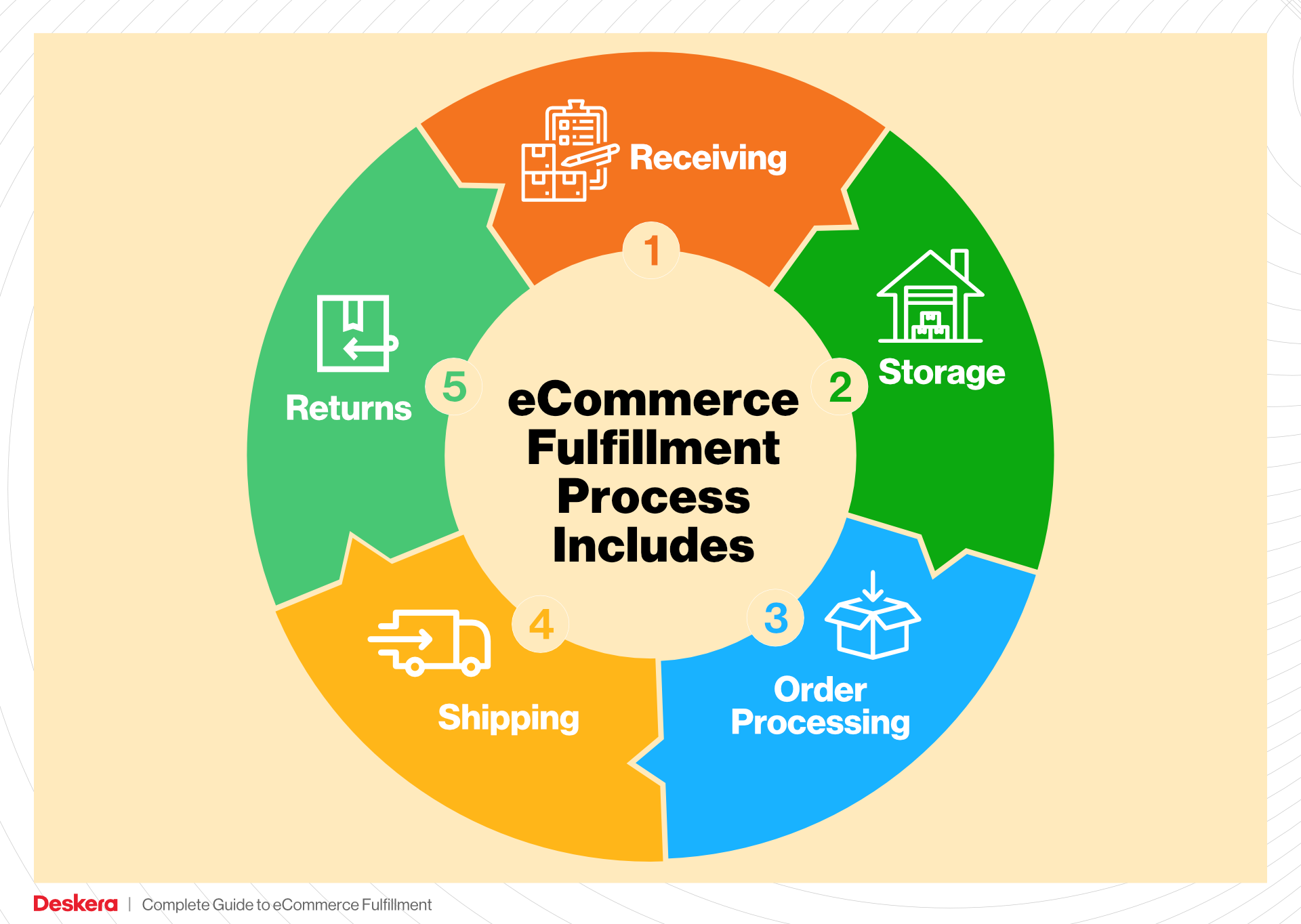
What You’ll Learn In This Guide
- What is E-commerce Fulfillment? An Introduction for Growing Businesses
- The Order Fulfillment Process: From ‘Buy’ Button to Customer’s Door
- Comparing Fulfillment Models: In-House vs. 3PL vs. Dropshipping
- A Deep Dive into Amazon FBA: Pros, Cons, and Who It’s For
- Core Services Offered by Fulfillment Centers
- How to Choose a Fulfillment Partner: A 6-Point Checklist
- Understanding Fulfillment Pricing: A Breakdown of Common Fees
- Frequently Asked Questions (FAQs) about Fulfillment
- Conclusion: Is Outsourcing Fulfillment the Right Move for Your Business?
- Important Disclaimer
The Order Fulfillment Process: From ‘Buy’ Button to Customer’s Door
1. Receiving Inventory
The first step in the order fulfillment process is receiving inventory. This involves the acceptance of goods from suppliers or manufacturers at the fulfillment center. Upon arrival, the products undergo a thorough inspection to ensure that they match the purchase orders in terms of quantity and quality. This step is crucial because it sets the foundation for the entire fulfillment process. Any discrepancies can lead to stockouts or excess inventory, which can disrupt operations and affect customer satisfaction.
Key to this process is the use of Stock Keeping Units (SKUs). SKUs are unique identifiers assigned to each product that facilitate tracking and inventory management. By accurately recording SKUs upon receipt, businesses can maintain real-time visibility of their inventory levels, enabling them to make informed decisions about restocking and order management.
2. Warehouse Storage
Once the inventory is received and verified, it is then stored within the warehouse. The organization of warehouse space is essential for efficient operations. Products are strategically placed based on various factors, such as their size, demand frequency, and storage requirements. This organization not only optimizes space but also minimizes the time spent retrieving products when orders are placed.
Effective warehouse storage strategies often involve the implementation of ABC analysis, which categorizes inventory into three classes (A, B, and C) based on their value and turnover rates. Class A items are high-value products that sell quickly and require close management, while Class C items are lower-value and slower-moving. By optimizing storage based on these classifications, businesses can significantly enhance their order fulfillment speed and efficiency.
3. Order Picking
Order picking is the process of retrieving the specific items from the warehouse to fulfill customer orders. This step is vital as it directly impacts the speed and accuracy of order fulfillment. An efficient picking process ensures that customers receive their products on time and without errors, thereby improving overall customer satisfaction and loyalty.
There are several methods for order picking, including single order picking, batch picking, and zone picking. In single order picking, a picker retrieves items for one order at a time. Batch picking allows pickers to collect items for multiple orders simultaneously, while zone picking divides the warehouse into sections, with pickers responsible for specific areas. Choosing the right picking method depends on the volume of orders and the layout of the warehouse, and it can significantly affect operational efficiency.
4. Order Packing
After items have been picked, they move to the packing stage. Here, products are carefully packaged to ensure they arrive at the customer’s location in perfect condition. This step is crucial because proper packing not only protects the items during transit but also enhances the unboxing experience for the customer.

Key aspects of order packing include selecting appropriate packaging materials and creating packing slips that include order details and return instructions. The use of branded packaging can also serve as a marketing tool, reinforcing brand identity and creating a memorable experience for customers. Automation tools, such as packing machines and software that optimize packing configurations, can further streamline this process, reducing labor costs and minimizing errors.
5. Shipping & Delivery
The final step in the order fulfillment process is shipping and delivery. Once the order is packed, it is labeled and sent to the appropriate shipping carriers for delivery. This step is critical as it involves logistics coordination and communication with shipping partners to ensure timely delivery.
Shipping labels are generated during this stage, containing essential information such as the destination address and tracking number. Providing customers with tracking information is vital for transparency and can enhance customer satisfaction. Moreover, businesses must choose the right shipping method based on cost, speed, and reliability, balancing customer expectations with operational efficiencies. Utilizing multiple carriers can help businesses remain competitive and responsive to fluctuating demands.
By mastering these five steps—receiving inventory, warehouse storage, order picking, order packing, and shipping & delivery—e-commerce businesses can create a streamlined order fulfillment process that enhances customer satisfaction and drives growth. Implementing best practices in each area not only improves operational efficiency but also lays the groundwork for scaling operations effectively in the competitive e-commerce landscape.
Comparing Fulfillment Models: In-House vs. 3PL vs. Dropshipping
Comparison of Fulfillment Models
| Model | Who Handles Inventory | Best For (Business Stage) | Key Advantage | Key Disadvantage |
|---|---|---|---|---|
| In-House Fulfillment | Business itself | Established businesses with steady demand | Full control over inventory and operations | High overhead costs and complexity |
| Third-Party Logistics (3PL) | External logistics provider | Growing businesses seeking scalability | Reduced operational burden and flexibility | Less control over fulfillment processes |
| Dropshipping | Supplier | Startups and businesses with limited capital | Low upfront investment and risk | Lower profit margins and less control over inventory |
In-House Fulfillment
In-house fulfillment involves a business managing its own inventory and logistics processes. This model is most suitable for established businesses with consistent demand for their products. Companies like Chewy, which operate numerous fulfillment centers, exemplify this model, as they can maintain a high level of control over their inventory and shipping processes. The main advantage of in-house fulfillment is the ability to customize operations, ensuring that the business can adapt quickly to customer needs and preferences. Additionally, businesses can implement quality control measures to maintain product standards. However, this model comes with significant overhead costs, including warehousing, staffing, and technology investments. As businesses scale, the complexity of managing logistics can also increase, requiring sophisticated systems to track inventory, orders, and shipping.
Third-Party Logistics (3PL)
Third-party logistics (3PL) is a model where businesses outsource their logistics operations to specialized providers. This model is particularly beneficial for growing businesses that seek to scale their operations without the burden of managing logistics themselves. 3PL providers handle various aspects of the supply chain, including warehousing, inventory management, and shipping, allowing businesses to focus on core activities like marketing and product development. The primary advantage of utilizing a 3PL is the flexibility it offers; businesses can easily adjust their logistics needs based on demand fluctuations without the need to invest heavily in infrastructure. However, the downside is that businesses relinquish some control over their fulfillment processes, which can lead to inconsistencies in service quality or delays if the 3PL provider does not meet expectations. Effective communication and partnership with the 3PL are essential to mitigate these risks.
Dropshipping
Dropshipping is a fulfillment model where the retailer does not keep products in stock. Instead, when a customer places an order, the retailer purchases the item from a third party, typically a wholesaler or manufacturer, who then ships it directly to the customer. This model is ideal for startups and entrepreneurs with limited capital, as it requires minimal upfront investment in inventory. The primary advantage of dropshipping is the low financial risk; businesses do not need to purchase products until they make a sale, which also eliminates the costs associated with warehousing. However, dropshipping has notable disadvantages, including lower profit margins due to reliance on suppliers and limited control over inventory and shipping times. Additionally, because the retailer does not handle the product directly, issues such as stockouts or quality control can lead to customer dissatisfaction. As a result, businesses using dropshipping must prioritize finding reliable suppliers and maintaining effective communication with them.
In conclusion, the choice of fulfillment model depends significantly on the stage of the business and its operational goals. Each model has distinct advantages and disadvantages that can impact overall performance, customer satisfaction, and scalability. By carefully evaluating their needs, businesses can select the fulfillment strategy that best aligns with their growth objectives and operational capabilities.
A Deep Dive into Amazon FBA: Pros, Cons, and Who It’s For
Understanding Fulfillment by Amazon (FBA)
Fulfillment by Amazon (FBA) is a service provided by Amazon that allows sellers to store their products in Amazon’s fulfillment centers. Amazon takes care of storage, packaging, and shipping, as well as customer service and returns. This service is designed to simplify the logistics involved in selling products online, enabling sellers to focus on growing their business.
How FBA Works
-
Product Listing: Sellers create product listings on Amazon and opt into the FBA program. They can either ship their products to Amazon’s warehouses or create shipments directly from their suppliers.
-
Inventory Management: Once the products are received at Amazon’s fulfillment centers, they are stored until sold. Sellers can track their inventory levels through their Amazon Seller Central account.
-
Order Fulfillment: When a customer places an order, Amazon picks, packs, and ships the product directly to the customer. This process is automated, ensuring quick delivery times.
-
Customer Service: Amazon handles all customer inquiries and returns for FBA products, providing sellers with the advantage of Amazon’s customer service expertise.
-
Fees: Sellers are charged fees based on the storage space their products take up and the fulfillment services used. These fees vary depending on the size and weight of the products.
Pros of Using FBA
-
Prime Eligibility: Products fulfilled through FBA are eligible for Amazon Prime, which can significantly increase visibility and sales. Prime members are more likely to purchase items that offer free two-day shipping.
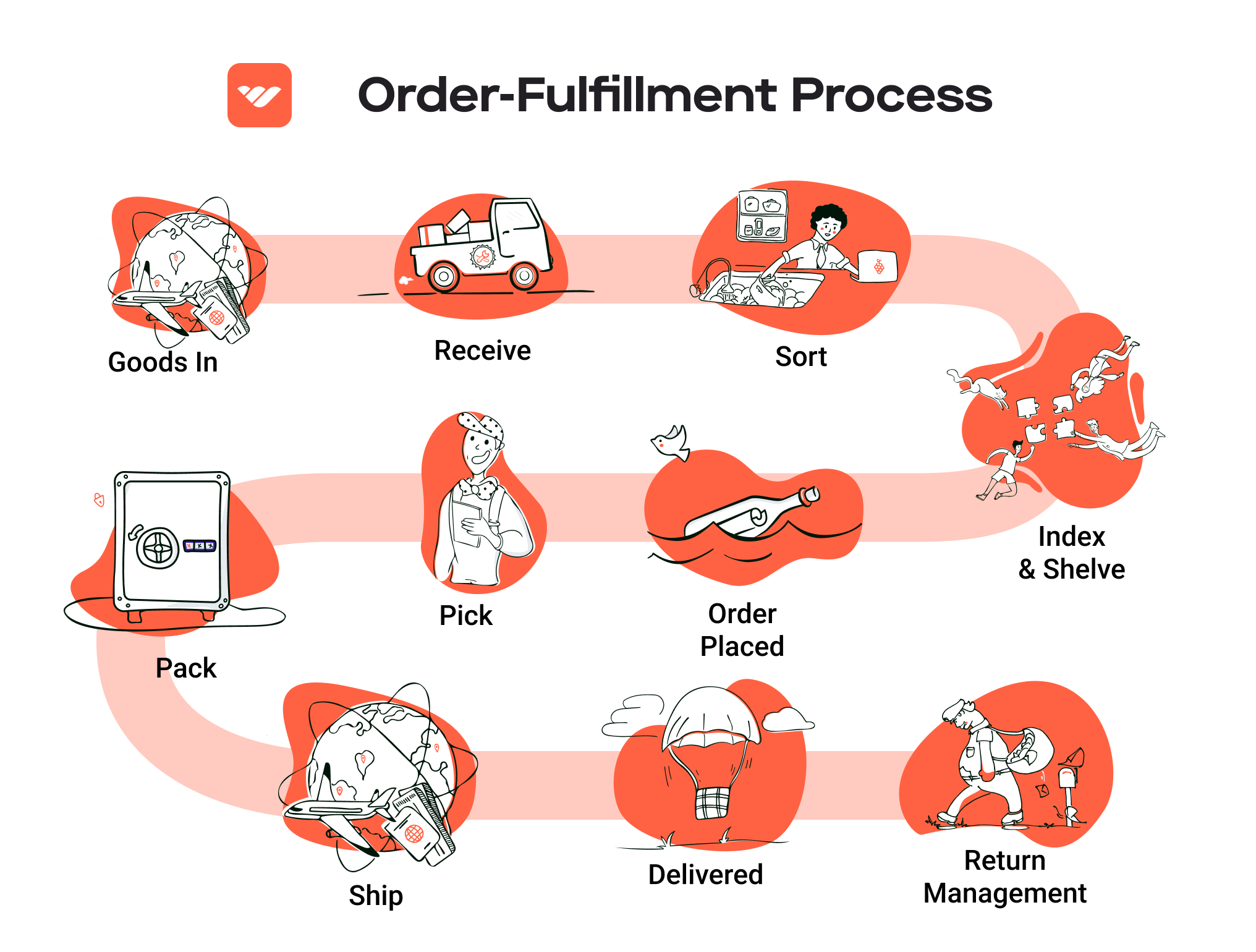
-
Customer Trust: Selling through FBA allows sellers to leverage Amazon’s reputation for reliability and customer service. This can enhance customer trust and increase conversion rates.
-
Multi-Channel Fulfillment: FBA can be used to fulfill orders from other sales channels, such as a seller’s own website or other marketplaces. This flexibility allows businesses to streamline their logistics across different platforms.
-
Scalability: FBA allows sellers to scale their operations without the need to invest heavily in warehouse space or staffing. Amazon’s infrastructure can handle increased order volumes seamlessly.
-
Simplified Returns: Amazon’s efficient return process can enhance customer satisfaction, as customers can easily return items, which can lead to increased loyalty.
Cons of Using FBA
-
High Fees: FBA fees can add up quickly, especially for small sellers. Costs include storage fees for inventory and fulfillment fees per unit sold. These expenses can eat into profit margins, particularly for low-cost items.
-
Strict Inventory Rules: Amazon enforces strict inventory management rules. Sellers must keep track of their inventory levels, and failing to do so can result in additional fees or penalties.
-
Commingling Risks: FBA allows for commingling of inventory, meaning that products from different sellers may be stored together. This can lead to issues if a seller’s products are damaged or if there are discrepancies in product quality.
-
Loss of Control: By using FBA, sellers relinquish some control over their fulfillment process. This can be a concern for brands that prioritize their customer experience and wish to manage their shipping and handling.
-
Limited Customization: The packaging and shipping options are standardized through Amazon, which may not align with a seller’s branding strategy. Custom packaging can create a unique customer experience, but this is not possible with FBA.
Who is FBA Best For?
FBA is particularly well-suited for:
-
Small to Medium-Sized Businesses: Those looking to scale quickly without the overhead costs associated with warehousing and logistics can benefit significantly from FBA.
-
Sellers with High Volume Sales: Businesses that sell a large volume of products, particularly those that are eligible for Prime, will find that the efficiencies gained through FBA often outweigh the costs.
-
E-commerce Entrepreneurs: New sellers who want to establish credibility and leverage Amazon’s extensive customer base can use FBA to jumpstart their sales.
-
Brands Focused on Customer Service: Companies that prioritize customer satisfaction but lack the resources to manage returns and inquiries can benefit from Amazon’s robust customer service capabilities.
-
Businesses with Seasonal Products: Sellers with seasonal or fluctuating product demand can use FBA to manage inventory levels without committing to long-term storage solutions.
In conclusion, Fulfillment by Amazon offers a streamlined and efficient solution for e-commerce businesses looking to scale operations and tap into Amazon’s vast customer base. However, it is essential for sellers to weigh the pros and cons carefully and consider their specific business needs before opting into the FBA program.
Core Services Offered by Fulfillment Centers
Inventory Management & Warehousing
Inventory management and warehousing are fundamental services provided by fulfillment centers. This service encompasses the systematic oversight of stock levels, order processing, and the storage of goods. Fulfillment centers utilize sophisticated inventory management systems to track product quantities in real-time, ensuring that e-commerce businesses maintain optimal stock levels without overstocking or understocking.
Benefits for E-commerce Businesses:
1. Enhanced Accuracy: Automated systems reduce human error, ensuring that inventory counts are precise. This accuracy is crucial for avoiding stockouts or excess inventory, which can tie up capital.
2. Space Optimization: Fulfillment centers provide the necessary space to store products, freeing up valuable real estate for e-commerce businesses to use for other purposes, such as customer service or marketing.
3. Scalability: As your business grows, fulfillment centers can easily scale operations. They can accommodate increased inventory levels and order volumes without the need for businesses to invest in additional warehouse space or staff.
4. Cost Efficiency: By outsourcing inventory management, businesses can reduce overhead costs associated with warehousing, including utilities, rent, and labor. Fulfillment centers often operate at a larger scale, allowing them to negotiate better rates for storage and logistics.
Pick and Pack Services
Pick and pack services involve the process of selecting products from inventory (picking) and packing them for shipment to customers. This service is critical for e-commerce businesses, as it directly impacts the speed and accuracy of order fulfillment. Fulfillment centers employ trained staff and technology, such as barcode scanning, to ensure that the right items are picked and packed efficiently.
Benefits for E-commerce Businesses:
1. Faster Order Processing: With dedicated teams focused solely on picking and packing, orders are processed more quickly than if done in-house. This speed is vital for maintaining customer satisfaction and loyalty.
2. Improved Order Accuracy: The use of technology in the picking process minimizes the likelihood of errors, ensuring that customers receive the correct items. This accuracy reduces return rates and enhances the overall customer experience.
3. Custom Packaging Options: Fulfillment centers can offer customized packaging solutions, allowing businesses to enhance their branding. Whether it’s branded boxes or eco-friendly materials, these options can improve customer perception and satisfaction.
4. Scalability During Peak Seasons: Fulfillment centers can efficiently manage surges in order volume during peak seasons (e.g., holidays) without compromising service quality. This flexibility allows businesses to focus on sales and marketing during high-demand periods.
Kitting and Assembly
Kitting and assembly services involve grouping multiple products into a single package (kitting) or assembling products before shipping. This service is particularly beneficial for businesses that sell bundles or complex products that require assembly before reaching the customer.
Benefits for E-commerce Businesses:
1. Streamlined Operations: By outsourcing kitting and assembly, businesses can streamline their operations, saving time and labor costs associated with in-house assembly.
2. Increased Product Appeal: Kitting allows businesses to create attractive bundles that can enhance the value proposition for customers. This can lead to higher average order values and improved sales.
3. Inventory Management Simplification: Kitting helps simplify inventory management. Instead of tracking numerous individual products, businesses can manage fewer SKUs by offering bundled products, reducing complexity.
4. Focus on Core Competencies: By outsourcing these processes, businesses can focus on their core competencies such as product development and marketing, rather than the logistics of assembly and kitting.
Returns Management (Reverse Logistics)
Returns management, or reverse logistics, is the process of handling returned goods. Fulfillment centers provide a structured approach to managing returns, including receiving, inspecting, restocking, or disposing of products. Efficient returns management is vital for e-commerce businesses, as it affects customer satisfaction and retention.
Benefits for E-commerce Businesses:
1. Enhanced Customer Experience: A seamless return process boosts customer confidence in making purchases. When customers know they can easily return items, they are more likely to complete a purchase.
2. Cost Efficiency: Fulfillment centers can manage returns more efficiently than many e-commerce businesses can in-house, reducing the costs associated with processing returns. They can quickly determine whether items can be restocked or need to be returned to suppliers.
3. Data Insights: Returns management provides valuable data on customer preferences and product issues. Analyzing return reasons can help businesses improve product offerings and reduce future returns.
4. Reputation Management: Efficient handling of returns enhances a company’s reputation. Customers are more likely to recommend businesses that make returns hassle-free, contributing to customer loyalty and brand advocacy.
In summary, the services provided by fulfillment centers are vital for e-commerce businesses looking to streamline operations, enhance customer satisfaction, and scale efficiently. By leveraging these core services, businesses can focus on growth while ensuring that logistics and fulfillment are handled by experts in the field.
How to Choose a Fulfillment Partner: A 6-Point Checklist
Location & Warehouse Network
Importance:
The geographical location of your fulfillment partner’s warehouses can significantly impact shipping times and costs. A strategically placed warehouse network allows for faster delivery to your customers, reducing shipping expenses and improving overall customer satisfaction.
Questions to Ask:
– Where are your fulfillment centers located, and how does that affect shipping times to my primary customer base?
– Do you have multiple warehouses, and can you ensure coverage for regional distribution?
– How do you handle shipping to international customers, if applicable?
Technology & Integrations
Importance:
In today’s e-commerce landscape, technology plays a crucial role in efficiency and accuracy. Your fulfillment partner should offer robust technology solutions that seamlessly integrate with your existing systems (like your e-commerce platform, ERP, or inventory management systems).
Questions to Ask:
– What technology do you use for inventory management, order processing, and shipping?
– Can your system integrate with my e-commerce platform and other tools I currently use?
– Do you offer real-time tracking for orders, and how do you communicate updates to customers?
Specializations (e.g., cold storage, oversized items)
Importance:
Different products require different handling and storage capabilities. If your business deals with perishable goods, hazardous materials, or oversized items, it’s essential to partner with a fulfillment center that specializes in these areas to ensure compliance and efficiency.
Questions to Ask:
– What types of products do you specialize in handling?
– Do you have specific facilities for cold storage or specialized storage needs?
– How do you ensure compliance with regulations regarding the storage and shipping of specialized items?
Scalability & Capacity
Importance:
As your business grows, your fulfillment partner must be able to scale operations without compromising service quality. Assessing their capacity to handle increased order volumes is essential for long-term partnerships.
Questions to Ask:
– What is your current capacity, and how do you manage peak seasons or unexpected surges in demand?
– Can you scale up operations quickly if my business experiences rapid growth?
– How do you handle inventory management during seasonal fluctuations?
Pricing and Contracts
Importance:
Understanding the cost structure and contractual obligations of your fulfillment partner is critical. Transparent pricing models will help you budget effectively and avoid unexpected costs that can erode your profit margins.
Questions to Ask:
– Can you provide a detailed breakdown of your pricing structure, including any hidden fees?
– What are the contract terms, and is there flexibility for renegotiation as my needs change?
– How do you handle billing for additional services, such as returns processing or custom packaging?
Customer Support & Reviews
Importance:
Reliable customer support can make or break a partnership. You want a fulfillment partner that offers responsive and helpful support, especially during challenging times. Additionally, reviewing feedback from other customers can provide insights into their service quality and reliability.
Questions to Ask:
– What kind of customer support do you offer, and what are your response times?
– Can you provide references or case studies from current clients in my industry?
– How do you handle issues such as order discrepancies, shipping delays, or damaged goods?
Conclusion
Choosing the right fulfillment partner is a critical decision that can significantly influence your e-commerce business’s success. By using this checklist, you can systematically evaluate potential partners based on the most crucial factors, ensuring that you select a provider that aligns with your operational needs and growth ambitions. Remember, the goal is not only to find a partner who can meet your current needs but also one that can grow alongside your business and help you navigate the ever-evolving e-commerce landscape.
Understanding Fulfillment Pricing: A Breakdown of Common Fees
Initial Setup Fees
Initial setup fees are typically charged when you first begin using a fulfillment center’s services. These fees can vary significantly depending on the provider and the complexity of your operations. Generally, they cover the costs associated with integrating your systems with the fulfillment center, including software setup, account configuration, and any necessary training for your team.
Calculation: Setup fees can be a flat fee or based on the number of SKUs (stock keeping units) you need to manage. For example, a fulfillment center may charge a standard fee for setting up your account, plus an additional amount for each SKU you integrate into their system. It’s crucial to clarify what services are included in this fee to avoid unexpected costs.
Receiving Fees
Receiving fees are charged when the fulfillment center takes possession of your inventory. This fee typically covers the labor and resources required to unload, inspect, and inventory your products as they arrive at the warehouse.
Calculation: These fees are usually calculated per unit or per pallet received. Some fulfillment centers may also have minimum charges or tiered pricing based on the volume of goods being received. For instance, if you send a large shipment, the per-unit cost may decrease as the quantity increases, incentivizing larger shipments.
Storage Fees (per pallet/bin)
Storage fees are charged for the space your products occupy within the fulfillment center. These fees can be based on the amount of space your inventory takes up, measured in pallets or bins, and are generally assessed on a monthly basis.
Calculation: Storage fees can vary depending on the size and weight of your products. For example, a fulfillment center may charge a standard rate per pallet per month, which could be lower for bulk items compared to smaller, high-value items that require more careful handling. Additionally, some providers may implement seasonal adjustments, increasing fees during peak periods when space is at a premium.
Pick & Pack Fees (per item/order)
Pick and pack fees are incurred when the fulfillment center picks your products from storage, packs them for shipment, and prepares them for delivery. This fee is crucial for understanding the overall cost of order fulfillment, as it directly correlates with the number of orders processed.
Calculation: Pick and pack fees can be charged per item or per order. For example, a fulfillment center might charge a flat fee for each order processed, plus an additional fee for each item picked. It’s important to note that the more complex your order fulfillment process (e.g., custom packaging or kitting), the higher these fees may be.
Shipping Fees
Shipping fees are the costs associated with delivering your products to customers. These fees can vary based on factors such as the destination, shipping method, and the size and weight of the package.
Calculation: Shipping fees are typically calculated based on the carrier’s rates, which can differ significantly. Many fulfillment centers offer discounted shipping rates due to their volume, which can lead to significant savings for your business. Additionally, shipping fees may be affected by your choice of expedited services, international shipping, or additional services like insurance or signature confirmation.
Tips for Getting an Accurate Quote
To ensure you receive an accurate quote from a fulfillment center, consider the following tips:
-
Provide Detailed Information: Share comprehensive details about your products, including dimensions, weights, and any special handling requirements. This information helps fulfillment centers provide more precise estimates.
-
Discuss Your Business Model: Explain your order volume, typical order sizes, and seasonal fluctuations. Understanding your business model allows fulfillment centers to offer tailored pricing models that align with your needs.
-
Ask About All Fees: Inquire about all potential fees, including hidden costs that may not be immediately apparent. Ensure you understand how each fee is calculated and any minimum charges that might apply.
-
Request a Trial Period: If possible, negotiate a trial period to assess the fulfillment center’s services before committing to a long-term contract. This can help you evaluate their efficiency and identify any unforeseen costs.
-
Compare Multiple Providers: Don’t settle for the first quote you receive. Compare offers from multiple fulfillment centers to ensure you’re getting the best value for your business.
By understanding these common fulfillment pricing models and following these tips, you can better navigate the complexities of fulfillment costs and make informed decisions that support your e-commerce growth.
Frequently Asked Questions (FAQs) about Fulfillment
1. What is the Chewy Fulfillment Center MCI1?
The Chewy Fulfillment Center MCI1 is one of Chewy’s state-of-the-art distribution facilities located in Belton, Missouri. It plays a critical role in ensuring that pet products are efficiently picked, packed, and shipped to customers across the country, supporting Chewy’s commitment to fast and reliable service.
2. How does Chewy ensure efficient order fulfillment at MCI1?
Chewy employs a combination of advanced technology and automated systems to streamline operations at MCI1. This includes the use of automated picking systems and real-time inventory management, which help reduce processing times and enhance accuracy in order fulfillment.
3. What are the benefits of using Chewy’s fulfillment services?
Utilizing Chewy’s fulfillment services offers several advantages, including:
– Speed: Quick turnaround times for order processing and shipping.
– Cost Efficiency: Reduced shipping costs through optimized logistics.
– Scalability: Ability to easily scale operations to match demand fluctuations.
– Expertise: Access to Chewy’s extensive experience in the pet product market.
4. What is the difference between a warehouse and a fulfillment center?
A warehouse is primarily used for storage, focusing on holding inventory until it is needed. In contrast, a fulfillment center is designed for the entire order processing cycle, including receiving, storing, picking, packing, and shipping products directly to customers. Fulfillment centers are more dynamic and focused on delivering goods quickly and efficiently.
5. What is a 3PL and how does it relate to Chewy?
A Third-Party Logistics (3PL) provider is a company that offers outsourced logistics services, including transportation, warehousing, and order fulfillment. Chewy operates its own fulfillment centers like MCI1, but also collaborates with 3PLs to enhance its logistics capabilities and meet growing demand.
6. How much do fulfillment services cost?
The cost of fulfillment services can vary widely depending on several factors, including:
– Volume of Orders: Higher volumes typically lead to lower per-order costs.
– Type of Products: Specialized products may incur additional handling fees.
– Shipping Destinations: Costs can vary based on the distance and shipping methods.
– Additional Services: Features like kitting, custom packaging, or returns management may also affect pricing.
7. What types of products can be fulfilled through Chewy’s MCI1 center?
MCI1 specializes in pet-related products, including pet food, toys, grooming supplies, and healthcare items. The facility is equipped to handle a wide range of items, ensuring that pet owners receive the products they need promptly.
8. How does Chewy handle inventory management at MCI1?
Chewy employs sophisticated inventory management systems that utilize real-time data to track stock levels, manage reordering, and forecast demand. This minimizes the risk of stockouts and ensures that popular products are always available for customers.
9. Can businesses partner with Chewy for fulfillment services?
Yes, businesses can partner with Chewy to utilize their fulfillment services. Chewy’s extensive infrastructure and expertise in the pet industry make it an attractive option for brands looking to scale their logistics operations efficiently.
10. What are the job opportunities at the Chewy Fulfillment Center MCI1?
Chewy offers various employment opportunities at MCI1, including roles in warehousing, operations management, and logistics. The company emphasizes a safety-first work environment and provides competitive wages, benefits, and opportunities for career growth within the organization.
Conclusion: Is Outsourcing Fulfillment the Right Move for Your Business?
Evaluating the Benefits of Outsourcing Fulfillment
Outsourcing fulfillment can be a transformative strategy for e-commerce businesses seeking to enhance efficiency and drive growth. One of the primary advantages is time savings. By partnering with a specialized fulfillment service, you can delegate the complexities of inventory management, order processing, and shipping logistics. This allows you to focus on core business activities such as marketing and product development, ultimately leading to better customer engagement and increased sales.
Scalability is another significant benefit. As your business grows, so too will the demands on your logistics operations. A fulfillment partner can seamlessly adjust to changes in order volume, ensuring that you can scale operations without the burden of investing in additional warehouse space or staff. This flexibility is particularly crucial during peak seasons or promotional events when order volumes can fluctuate dramatically.
Moreover, tapping into the expertise of a fulfillment service can lead to improved operational efficiencies. These partners often employ advanced technologies and best practices that may not be feasible for smaller businesses to implement independently. From automated inventory systems to optimized shipping routes, leveraging such expertise can enhance delivery speed and accuracy, leading to higher customer satisfaction.
However, the decision to outsource fulfillment should not be taken lightly. Choosing the right partner is critical to your success. It’s essential to evaluate potential fulfillment providers based on their capabilities, experience, and alignment with your business goals.
Take Action
To determine if outsourcing fulfillment is the right move for your business, conduct a thorough audit of your current shipping processes. Analyze areas where inefficiencies may exist and assess whether a fulfillment partner could address these challenges. This strategic evaluation can provide clarity on the potential benefits of outsourcing and set the stage for sustainable growth.
Important Disclaimer
⚠️ Important Disclaimer
The information in this guide is for educational purposes. Fulfillment services, pricing, and platform features change frequently. Always conduct your own due diligence and consult with providers directly before making business decisions.
